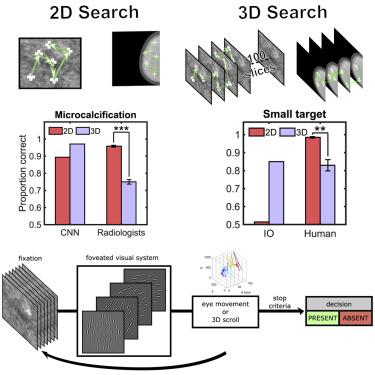Current Biology ( IF 8.1 ) Pub Date : 2021-01-19 , DOI: 10.1016/j.cub.2020.12.029 Miguel A Lago 1 , Aditya Jonnalagadda 2 , Craig K Abbey 1 , Bruno B Barufaldi 3 , Predrag R Bakic 3 , Andrew D A Maidment 3 , Winifred K Leung 4 , Susan P Weinstein 3 , Brian S Englander 3 , Miguel P Eckstein 5

|
Advances in 3D imaging technology are transforming how radiologists search for cancer1,2 and how security officers scrutinize baggage for dangerous objects.3 These new 3D technologies often improve search over 2D images4,5 but vastly increase the image data. Here, we investigate 3D search for targets of various sizes in filtered noise and digital breast phantoms. For a Bayesian ideal observer optimally processing the filtered noise and a convolutional neural network processing the digital breast phantoms, search with 3D image stacks increases target information and improves accuracy over search with 2D images. In contrast, 3D search by humans leads to high miss rates for small targets easily detected in 2D search, but not for larger targets more visible in the visual periphery. Analyses of human eye movements, perceptual judgments, and a computational model with a foveated visual system suggest that human errors can be explained by interaction among a target’s peripheral visibility, eye movement under-exploration of the 3D images, and a perceived overestimation of the explored area. Instructing observers to extend the search reduces 75% of the small target misses without increasing false positives. Results with twelve radiologists confirm that even medical professionals reading realistic breast phantoms have high miss rates for small targets in 3D search. Thus, under-exploration represents a fundamental limitation to the efficacy with which humans search in 3D image stacks and miss targets with these prevalent image technologies.
中文翻译:

三维图像探索不足导致小显着目标搜索错误
3D 成像技术的进步正在改变放射科医生搜索癌症的方式1 , 2以及安检人员检查行李中是否存在危险物品的方式。 3这些新的 3D 技术通常会改进 2D 图像的搜索4 、 5 ,但会大大增加图像数据。在这里,我们研究了过滤噪声和数字乳房模型中各种尺寸目标的 3D 搜索。对于贝叶斯理想观察者优化处理过滤噪声和卷积神经网络处理数字乳房模型而言,使用 3D 图像堆栈进行搜索可以增加目标信息,并提高使用 2D 图像搜索的准确性。相比之下,人类的 3D 搜索对于 2D 搜索中容易检测到的小目标会导致较高的漏失率,但对于在视觉外围更明显的较大目标则不然。对人眼运动、感知判断和具有中心凹视觉系统的计算模型的分析表明,人为错误可以通过目标的周边可见度、3D 图像探索不足的眼动以及对探索的感知高估之间的相互作用来解释。区域。指示观察者扩大搜索范围可减少 75% 的小目标遗漏,同时不会增加误报。 12 名放射科医生的研究结果证实,即使是医疗专业人员阅读真实的乳房模型,在 3D 搜索中对于小目标的漏失率也很高。因此,探索不足代表了人类在 3D 图像堆栈中搜索的效率的根本限制,并且使用这些流行的图像技术错过了目标。











































 京公网安备 11010802027423号
京公网安备 11010802027423号